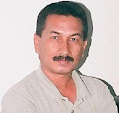 We have given our today for your better tomorrow! Yes, kargil war is almost ten year old now.People are heading for celebrations to make some more money.But how many know those silent heroes and their families living elsewhere in teh country?
We have given our today for your better tomorrow! Yes, kargil war is almost ten year old now.People are heading for celebrations to make some more money.But how many know those silent heroes and their families living elsewhere in teh country?Squadron Leader Ajay Ahuja was a IAF fighter pilot, whose death under controversial circumstances in the 1999 Kargil War in Kashmir, was the cause of the most angry public conflagration between India and Pakistan at the time. Sqn Ldr Ajay Ahuja was born in Kota of Rajasthan on 22 May 1963. Graduated from the National Defence Academy (NDA) and commissioned as fighter pilot from AFA on June 14, 1985 to the IAF.
Exper flying records for MiG-23 fighter-bomber and MiG-21 variants, as well as instructional flying experience of over 1,000 hours spent on teaching trainee pilots. Squadron Leader Ajay Ahuja was posted to the Killi Bhisiana Airbase at Bhatinda, Punjab, in 1997. He was the Flight Commander of No.17 Squadron Golden Arrows (a specialist photo-reconnaissance squadron), when the Kargil War broke out in May-June 1999.
On May 27, 1999, as part of Operation Safed Sagar in Kargil, a photo reconnaissance mission was launched over the Indian side of the line of control in Kashmir. A member of the mission, Flt Lt Nachiketa ejected from his MiG-27L after an engine flame out. Sqn Ldr Ahuja stayed over enemy positions to help the rescue attempts knowing full well the existence of enemy surface-to-air missiles in the area.
However, his MiG-21MF, C-1539 was hit by a shoulder-fired FIM-92 Stinger. Ahuja gave a radio call – "Hercules, I suspect a missile hit". IAF authorities lost track of his aircraft and all communication shortly afterwards.
According to the data released by the IAF, Ahuja's aircraft had been within the Indian side of the Line of Control, a ceasefire line and pseudo-border agreed upon by India and Pakistan in the early 1970s to maintain status quo in Kashmir. He ejected, but the ejection seat might have been landed (as that don’t have manual control) either in the LOC or Pak advanced area. Some sources said that since he was brave enough, while ambushed by Pak troops, fearing his brutal end with Pak hands, he might have shot dead some Pak soldiers while asking to surrender. That might lead to shot him in close range. A post-mortem examination conducted by Indian military authorities said that Ahuja had landed safely after ejecting from his plane, but had been killed by Pakistani soldiers.
The report revealed that Ahuja had been shot twice through the ear and chest. The Government of India lodged a strong protest with Pakistan's ambassador, sharply condemning this action by Pakistani soldiers The Government of Pakistan and Pakistani military authorities vehemently denied all accusations that Pakistani soldiers murdered Ahuja, a prisoner of war, and mutilated his body. Pakistan maintained that Ahuja was probably killed during the crash, or a victim of the vagaries of wartime, where it is impossible to keep track and protect every life, especially that of a downed enemy pilot.
No further investigations were carried out by either government nor impartial, outside entities. Both governments and their people stand by their respective version of events.
However, confirmation that Ahuja was alive when he landed came from an unexpected source - the website of a (then) serving PAF Officer.This website, set up by Air Cmde Kaiser Tufail confirms in its pages that Ahuja was killed 'in a shootout' on the ground.
On May 29 1999, Sqn Ldr Ahuja's body was flown in from Srinagar by an IAF plane. The body in a wooden coffin was brought to the local Air Force station from Srinagar by an Indian Air Force plane.
Indian politicians were also present at the military funeral ceremony, as were hundreds of local people, as well as political activists. Angry public demonstrations broke out there, at Ahuja's cremation, which was particularly emotional for Ahuja's family, friends and the gathered public, and near the Pakistani embassy in Delhi.
Ahuja remains a great hero in the eyes of India's people, and his widow and family are often honored guests at patriotic public events and official ceremonies. The family received much support from Government authorities and Indian political leaders, as well as emotional and financial support from people across India.
On August 15, 1999, India's 52nd anniversary of Independence, Squadron Leader Ajay Ahuja was posthumously awarded the Vir Chakra (Vr C), one of India's highest gallantry honors for military personnel.
His wife Mrs Alka Ahuja and a son Ankush lives elsewhere now.
Jai HInd!

1 comment:
Post a Comment